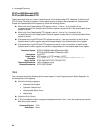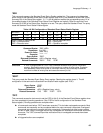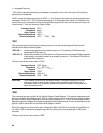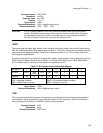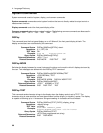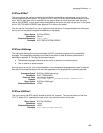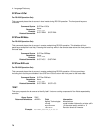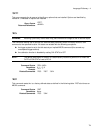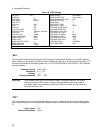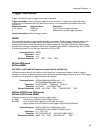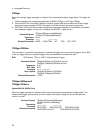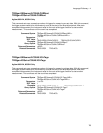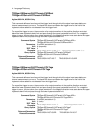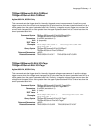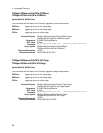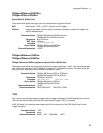
4 - Language Dictionary
72
Table 4-8. *RST Settings
CAL:STAT OFF [SOUR:]CURR 10% of MAX*
DIG:DATA 0 [SOUR:]CURR:TRIG 10% of MAX*
DISP:STAT ON [SOUR:]CURR:PROT:STAT OFF
DISP:MODE NORM [SOUR:]LIST:COUN 0
DISP:TEXT ‘ ‘ [SOUR:]VOLT 0
INIT:CONT OFF [SOUR:]VOLT:TRIG 0
OUTP OFF [SOUR:]VOLT:PROT MAX*
OUTP:DFI OFF TRIG:ACQ:COUN:CURR 1
OUTP:DFI:SOUR OFF TRIG:ACQ:COUN:VOLT 1
OUTP:PROT:DEL .08 Norm; .008 Fast TRIG:ACQ:HYST:CURR 0
OUTP:REL OFF TRIG:ACQ:HYST:VOLT 0
OUTP:REL:POL NORM TRIG:ACQ:LEV:CURR MAX*
SENS:CURR:RANG MAX TRIG:ACQ:LEV:VOLT MAX*
SENS:CURR:DET ACDC TRIG:ACQ:SLOP:CURR POS
SENS:FUNC VOLT TRIG:ACQ:SLOP:VOLT POS
SENS:SWE:OFFS:POIN 0 TRIG:ACQ:SOUR INTERNAL
SENS:SWE:POIN 2048 TRIG:TRAN:SOUR BUS
SENS:SWE:TINT 15.6 µs
* Maximum values are model-dependent. Refer to Table 4-3.
*SAV
This command stores the present state of the dc source to the specified location in non-volatile memory.
Up to 4 states can be stored. If a particular state is desired at power-on, it should be stored in location 0. It
will then be automatically recalled at power turn-on if OUTPut:PON:STATe is set to RCL0. *RCL retrieves
instrument states.
Command Syntax
*SAV <NRf>
Parameters
0 | 1 | 2 | 3
Example
*SAV 3
Related Commands
*RCL *RST
CAUTION: *SAV causes a write cycle to nonvolatile memory. Nonvolatile memory has a finite
maximum number of write cycles. Programs that repeatedly cause write cycles to
nonvolatile memory can eventually exceed the maximum number of write cycles and
cause the memory to fail.
*TST?
This query causes the to do a self-test and report any errors. 0 indicates that the dc source passed self-
test. 1 indicates that one or more tests failed. Selftest errors are written to the error queue (see Appendix
C).
Query Syntax
TST?
Returned Parameters
<NR1>



